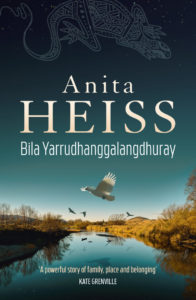Brenda Saunders reviews Bila Yarrudhanggalangdhuray by Anita Heiss
 Bila Yarrudhanggalangdhuray
Bila Yarrudhanggalangdhuray
by Anita Heiss
Reviewed by BRENDA SAUNDERS
In the ‘Prologue’, to her novel, Heiss introduces us to Aboriginal tribal life at the onset of colonial expnsion in southern NSW. This is Gundagai in 1838. She provides the historical setting for the action and events to follow. At this time Wagadhaany, the central Aboriginal character in this novel, is a small child living with her family along the Marrambidja Bila (Murrumbidgee River). She hears the adults complaining about the changes, the loss of their land, the clearing of their hunting grounds. They don’t understand why the settlers won’t listen to their advice. Heiss introduces the reader to Wiradjuri words and names, which give greater authenticity to her description of the river people and their culture. There is a glossary of Wiradjuri words and reference notes included at the end of the book.
The novel opens and ends with two dramatic events, two tragedies caused by the great river. In 1853, Wagadhaany is now a young woman working as a domestic for the Bradley family. She is allowed to visit her family camp on Sundays, where she joins in celebrations by the river, speaking her own language freely. In English her name means ‘dancer’ and she readily joins in camp celebrations. The river becomes a metaphor for the power of the natural environment: respected by the local clans, misunderstood by the white settlers, it is both a danger and an essential element for survival.
In the first chapter, Heiss takes us to the historic great flood, when the small trading town of Gundagai and low-lying properties were completely inundated by rising river currents. Many people drowned, but several were rescued by the bravery of local Aboriginal men.
Wagadhaany and two Bradley brothers are saved by her father Yarri during the flood, but their parents and siblings are lost. During the town celebration, when Jacky Jacky and Yarri are given breast plates in recognition of their bravery, she wonders:
‘why… don’t they give the people on the river some more blankets and food. The breastplates will not keep them warm from the frost that continues to settle each night and early morning…hunting does not always bring enough for the entire camp.’
After the tragic flood the younger son James, becomes infatuated with a young widow, Louisa, a Quaker with strong views about women’s emancipation and Aboriginal dispossession. After their marriage, she is kind to her young servant and the two become unlikely friends. Unfortunately, she has no capacity to see the devastating effects on Wagadhaany when she is forced to leave her Wiradjuri family when the Bradleys move to a new property near Wagga Wagga.
Although a work of fiction the story of Wagadhaary is told in a narrative style, following the results of historic events due to the expansion of the pastoral industry in NSW. Heiss has brought into focus the struggles and the dignity of this Aboriginal woman, trying to survive between two cultures. Her character is intelligent and lively, her observations on the White community both wise and at times amusing.
She has become increasingly aware that White people live very separate lives to each other, and even simple sharing of food among families is not common.
Away from the problems at the cold Bradley homestead, Heiss shows us a different world at the Wiradjuri camps along the Murrumbidya, at Gundagai and Wagga Wagga; camps with many children, old aunties, cousins and a warm sense of belonging.
The introduction of Louisa’s character into this story serves to highlight the great dichotomy between the two cultures; between white middle class values and traditional Aboriginal customs. This lack of understanding, of listening is the grit of the novel. Louisa seems unaware of the social mores of the town, who regard Aboriginal people as uncivilized. Rather, she imposes her own high ideals of racial equality on her own terms. One example is the scene at the river when Louisa demands a visit to the river to see the children, suggesting they learn to read the bible!
Wangadhaany is the observer, registering the gradual changes, the conflicts and domestic violence in Louisa’s marriage. Louisa however does not observe the changes in her friend. She is unaware of her relationship with the successful drover Yindy, from the local river people. So when she becomes pregnant, Louisa is devastated, as she herself is childless.
Louisa drops the cup she is holding and it smashes on the hard floor. Pregnant? How can you be pregnant? You and Yindyamarra aren’t married!
For many years Wagadhaany has been grieving to return to her Wiradjuri people, so she tries to flee her situation. The NSW law gave the settlers complete control over the Aboriginal clans along the river, who were bound to them for life, as stockmen or domestics (The Master and Servant Act, 1848). Despite this, Yindy, Wagadhaany and their three small children decide to travel along the river to her own ‘miiyagan’.
But the journey ends in tragedy. While they are enjoying the freedom of river life, their baby daughter Miimi drowns on the strong current. Once more the Bila Yarrudhanggalangdhuray has become a Bila Mayilgan, a river of death.
BRENDA SAUNDERS is a prize winning Wiradjuri writer and artist. Her third poetry collection, Inland Sea was published in 2021 (Ginninderra Press) and her poetry and reviews appear regularly in anthologies and journals both on-line and in print, including Australian Poetry, Plumwood Mountain, Overland, Westerly, Best Australian Prose Poems 2020 (Melbourne University Press) and Best Australian Science Writing 2020 (NSW Publishing). Her prose poems and microfiction have featured as short films, (Voices of Women 2021) and audio projects such as ‘Sonic City’ (Spineless Wonders 2022). Brenda is Convenor of Round Table Poets at Writing NSW.